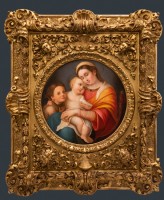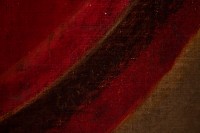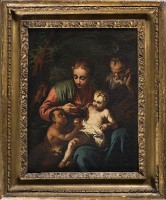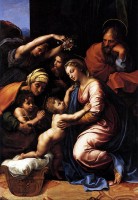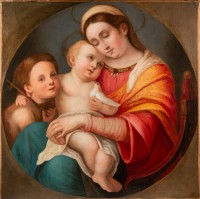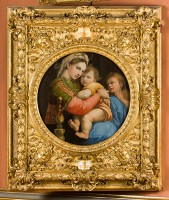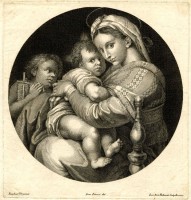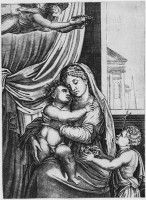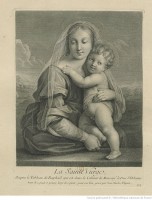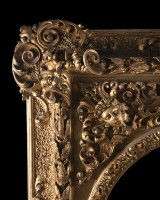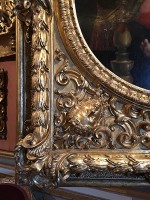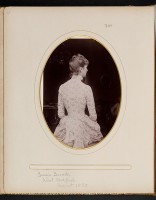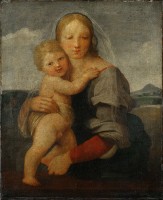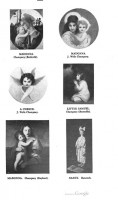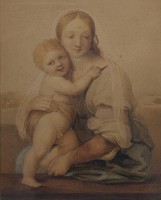The browser will either open the file, download it, or display a dialog.
No contemporary viewer educated in Western art history would mistake for an authentic Raphael the painting of the seated Madonna holding the Christ Child, with the young John the Baptist, which now resides in the McMullen Museum of Art at Boston College (fig. 1). Although competently painted in a naturalistic style with soft modeling, believable foreshortening, lively expressions, and effective coloristic effects, the painting lacks the insistently tangible figures, confident brushstrokes, and saturated palette of a Raphael painting. Yet, in 1866 this eighteenth-century painting by either Giambettino Cignaroli (1706–70) or his half-brother, Giuseppe Cignaroli (1727–96), was sold as an authentic Raphael to the New York businessman John Hunter and then to the wealthy Bostonian Peter Chardon Brooks. In the twentieth century, after its attribution to Raphael was deemed untenable, the Brooks family donated it to a local priest, who presumably gifted it to Boston College, a Jesuit Catholic university. Documentation in the McMullen Museum’s curatorial file led to the archival work that uncovered the traces of this fragmented and complex history.
In Igor Kopytoff’s 1986 essay “The Cultural Biography of Things: Commoditization as Process,” the anthropologist applies the concepts of human biography to objects and asks analogous questions: Where was the item made? Who made it? What is its career? What are the “ages” or periods of its life? How does the object’s function change in relation to these biographical ages? What happens when an object is no longer useful? Kopytoff’s goal in using this biographical approach is to study commodities and the process of commoditization. A commodity is a thing that can be exchanged for an equal value, and (in the West) its key characteristic is salability. During the life cycle of an object, however, culture can intervene and interrupt its value as a commodity through the process of singularization. This change happens when the object becomes non-salable and accrues “a special aura of apartness from the mundane and the common,” for either a group within a society or the “public culture” at large.[1] Like the ages of a human biography, this process of commoditization and singularization is in a state of continual becoming rather than being fixed or static. Through this transitional process, the object’s “status,” which is its standing or state within the culture, changes.
This process of commoditization offers a model for interpreting the McMullen Museum Madonna and Child with John the Baptist. The painting’s biography takes it from Verona to Paris, and then, possibly via London, to New York and Boston, during which time it experienced the cycle of commoditization and singularization. In late eighteenth-century Verona, the Madonna and Child with John the Baptist was presumably created as a commodity that was sold to a patron or collector. Once purchased, it became a devotional object or a collector’s item, something that was removed from the marketplace and accrued cultural status. In the nineteenth century, it was recommoditized when it twice reentered the marketplace as a Raphael. The acquisitions endowed it with the cultural status of a masterpiece. But at the century’s end, it was identified as a copy (not an original) and lost the status of celebrated authorship. This change resulted in its decommoditization; in the early twentieth century, it was valued as an object of worship, not a commodity with monetary value, and was gifted to a Jesuit Catholic university. In this series of transactions, persons with different interests exchanged the painting for its value and it moved back and forth between a commodity and a singular object.
The categories of commodity and singular object are not neat, and the cultural circumstances of each age and the perspectives of the persons involved in the transactions impact the status of the object. This nuance brings us to Kopytoff’s second point: a thing is “a culturally constructed entity, endowed with culturally specific meanings, and classified and reclassified into culturally constituted categories.”[2] The concept of cultural redefinition provides another model for interpreting the Madonna and Child with John the Baptist: in the second part of this article, the object becomes key to interpreting its cultural circumstances. The painting reveals “a wealth of cultural data” about the production of religious images in eighteenth-century Italy and especially the visual arts in nineteenth-century Boston, before Isabella Stewart Gardner acquired the first authentic Raphaels.[3] Gardner purchased, in 1898, Raphael’s Portrait of Tommaso Inghirami (ca. 1515–16) and, in 1900, his Pietà predella (ca. 1503–05). Following her acquisitions was the arrival of the first Raphael Madonnas, in 1901 Henry Walters’s Madonna of the Candelabra (ca. 1513) of disputed attribution and in 1913 Peter Widener’s Small Cowper Madonna (ca. 1505).[4] The biography of the McMullen Museum’s Madonna and Child with John the Baptist sheds new light on the commodity production of religious images in eighteenth-century Italy, as well as the market for old masters, the reception of Raphael, and the challenge of authenticating a European painting in nineteenth-century Boston. The interpretation of the painting’s biography suggests that despite the universal admiration of Raphael, nineteenth-century Boston lacked the resources to “see” the master’s oeuvre in color and to attribute a painting to him.
The Creation of a Devotional Painting
The painting’s subject of the Madonna and Child with John the Baptist and its tondo format link it to the category of Renaissance devotional pictures used for individual contemplation, of which Raphael’s Madonna of the Chair (Madonna della seggiola) (1513–14) is the epitome.[5] During the cleaning of the painting in 1950, the restorer removed old layers of varnish and revealed a small signature just below the arm of the chair (fig. 2), which he interpreted as Giuseppe Cignaroli.[6] Hailing from a family of painters, Cignaroli, also known as Fra Felice, was a Franciscan friar who worked in and around Verona in the second half of the eighteenth century and produced primarily altarpieces and sacred frescoes for churches. According to his biographers, he also made many devotional pictures and genre scenes for private patrons. Few of Cignaroli’s devotional paintings survive. His Holy Family (ca. 1770; Palazzo Ducale, Mantua; fig. 3) relies on Raphael, especially for the figure of Joseph, which was modeled after his counterpart in the Renaissance master’s The Holy Family of Francis I (1518; Louvre, Paris; fig. 4). Yet, Cignaroli’s darker shadows, sharp contours, and realism set him apart from Raphael. These formal characteristics also differ from the more even lighting, smoother brushstrokes, and idealized figures of the Madonna and Child with John the Baptist. Its style may be closer to that of Fra Felice’s half-brother, Giambettino Cignaroli, known for his devotional paintings of the Virgin and Child.[7] The attribution of the McMullen Museum painting, however, is beyond the scope of this study. Regardless of which Cignaroli painted the Madonna and Child with John the Baptist, he intentionally reinterpreted the Madonna of the Chair and other Raphael Madonnas, known from reproductions, through a process of emulation, assimilation, and transformation.
The composition, setting, and tondo format rely heavily on Raphael’s Madonna of the Chair, but significant differences suggest that Cignaroli did not aim for a replica of the famous prototype and instead worked creatively from the model to make a variant (figs. 5, 6).[8] This process differed significantly from the practice of replicating Madonna and Child compositions using the technique of spolvero (dusting a drawing with pin-pricked lines with charcoal to transfer a design to canvas), widely used by Renaissance “Madonnieri,” Vasari’s term for painters who churned out Madonna and Child paintings through mechanical copying from an original.[9] It also differed from the numerous copies made for commercial purposes by eighteenth-century artists standing before the original in the Palazzo Pitti, when grand tourists wished to return home with a copy of the famous prototype.[10] Cignaroli’s reversal of Raphael’s original composition and changes in palette suggest that he was looking at a print. Only a few of the many print reproductions of Raphael’s Madonna of the Chair show the composition in reverse: the anonymous print made for the indulgence of Gregory XIII in 1578; the print attributed to Jean Morin from the first half of the seventeenth century; and Giovanni Domenico Picchianti’s engraving from the late seventeenth or early eighteenth century (fig. 7).[11] The compositional differences do not end with the reversal. In the original, the Madonna and Child and the chair are positioned at an oblique angle to the picture plane, whereas in the variant, they are placed nearly frontal to it.
Along with these compositional differences, Cignaroli has reimagined the interaction of the figures, possibly inspired by other Raphael Madonnas. Rather than the outward gazes of Mother and Child, with John the Baptist adoringly looking at the Savior, it is Christ who does the adoring, and the object of adoration is his mother. She leans her cheek on her son’s head and modestly gazes downward. A similar interaction between the Madonna and Child is seen in Agostino Veneziano’s print after Raphael of the Madonna Crowned by an Angel (after 1515; fig. 8).[12] The features of Cignaroli’s Madonna, specifically her downward glance with heavy lids, elongated nose, and small, puckered lips, evoke Jean Charles Flipart’s engraving of La Sainte Vierge (1729; fig. 9), after Raphael’s Madonna and Child that had belonged to the Duc d’Orléans but now is known as the Mackintosh Madonna (ca. 1509–11; fig. 13; discussed below).[13] These similarities may suggest that Cignaroli borrowed and assimilated characteristics of various Raphael Madonnas, which he studied through prints. Although tenderness unites our variant with the models, Cignaroli inventively reinterpreted Raphael’s Madonna of the Chair. Whereas in 1764 Edward Gibbon interpreted Raphael’s Madonna as the perfect combination of sanctity and humanity, the variant amplifies her human character. Cignaroli represents a sentimental celebration of the relationship between mother and child, while signaling their special status with the overt symbolism of the dove.
To follow Kopytoff’s biographical interpretation of a thing: in this first age, the Madonna and Child with John the Baptist holds the status of a cultural object. The painting embodies the act of artistic creation through the time-honored practice of learning through emulation. In this case, Cignaroli emulated the best painter of the Madonna, Raphael.[14] In addition, he reimagined the subject matter of the original to create a devotional picture or a collector’s item that might stimulate reverence toward the sacred figures by appealing to the viewer’s human sensibility.
The Making of a Masterpiece: From Paris to New York, ca. 1830
In the early nineteenth century, the Madonna and Child with John the Baptist entered a second age in which its attribution to Cignaroli was obliterated (perhaps intentionally by covering the signature with varnish) and the object was recommoditized as a Raphael masterpiece. The vicissitudes of this transformation are known only from the auction catalogue of Mr. John Hunter’s Extensive Collection of Ancient and Modern Pictures at the Düsseldorf Galleries of Leeds and Miner, New York City, in 1866.[15] The preface praises Hunter’s collection as “doubtless the largest and finest collection of genuine works of the old masters ever offered for sale in the United States” and explains that Mr. Hunter (1778–1852) acquired the works principally between 1800 and 1835 through his agent, Mr. Hobson, “during the revolutionary troubles in France.”[16] Hunter was a wealthy New York businessman who had built a grand estate outside the city where he displayed his paintings.[17] If we are to believe the attributions to Domenichino, Guido Reni, Guercino, Carlo Maratti, Peter Paul Rubens, Anthony Van Dyck, Rembrandt, and others, then Hunter created a significant old masters collection in the United States before the renowned activities of James Jackson Jarves, Isabella Stewart Gardner, J. Pierpont Morgan, and Henry Clay Frick.[18]
But this is a big “if.” Hunter’s collection probably was similar to other private collections in antebellum New York whose old master paintings were of dubious authenticity. In fact, buying such paintings in the burgeoning art market of mid-nineteenth-century New York was risky, and many collectors therefore chose to acquire contemporary American and European paintings instead.[19] Hunter’s name does not appear in The Crayon’s series of articles, “Our Private Collections,” about six notable collections in New York City (1856) or in the collecting databases of the Frick’s Center for the History of Collecting and the Getty Provenance Index databases.[20] However, a buyer named Hobson does appear in the sales catalogues of the Getty database: Hobson purchased twenty-eight works in seven London auctions between 1787 and 1844.[21] Among the old master paintings and copies are ten drawings by Giovanni Battista Cipriani and a painting by Giovanni Paolo Panini. Although it is impossible to verify that Hobson was Hunter’s agent, the data provides some corroborating evidence for the existence of a dealer named Hobson and his acquisition of eighteenth-century Italian art. Finally, Francesco Freddolini has shown that in the nineteenth-century United States hyperbole characterizes auction catalogues to entice potential buyers, and the rhetoric of the Hunter catalogue accords with this marketing strategy of overly enthusiastic attributions.[22]
In the Hunter auction catalogue, the most detailed entry (number 292), Raffaelle, Madonna and Infant Saviour, carefully explains the status of the painting when it arrived in the United States: “This picture was considered by Mr. Hunter as the most valuable in his collection. It was purchased in Paris during the three days’ revolution [July Revolution of 1830], and was taken from the palace of Charles X. No doubt has existed as to its originality, and it is probably the only picture by the great master in this country.”[23] At this moment in the painting’s biography, the painting was a cultural object whose value derived from its authorship, rarity, and provenance. This was a transitional moment in which the singular object was transformed into a commodity. We do not know how the painting traveled from northern Italy to Paris—and potentially to London if Hobson acquired it there—before it reached Hunter in New York. Iain Pears has argued that in London’s increasingly complex art market, a painting could be purchased “as a speculative asset” and could pass through several hands before reaching a new owner.[24] The Madonna and Child with John the Baptist may have experienced such a passage in London, ending up in the hands of Hobson, who then sold it in New York. If this was the case, then during this age between Paris and New York, the painting became a commodity that was traded for greater monetary worth.
Physical evidence shows that the painting has been manipulated, and these changes may have been made for economic gain to transform the eighteenth-century devotional work into a masterpiece attributed to Raphael. As recorded in the 1866 auction catalogue, the measurements are 31 by 26 inches, but today the painting measures 29 1/4 by 29 1/8 inches. At an unknown moment, the original canvas was lined using an animal hide adhesive and then nailed onto a particle board.[25] These changes may have been made to fit the painting into a new frame. Robustly constructed and monumental, its frame is a near replica of the Madonna of the Chair’s frame, which was made in 1698 by the woodcarver Giovanni Magni, probably based on Giovanni Battista Foggini’s design (cf. figs. 1, 6).[26] Unlike Magni’s wholly wood frame, the McMullen frame combines molded plaster for the round inner frame and carved wood for the beautiful spandrels and outer frame. The molded plaster is relatively flat relief, whereas the wood decoration is sculptural and similar to Magni’s frame (figs. 10, 11). The spandrels of both frames have punchwork backgrounds. Andrew Haines, associate conservator of the Museum of Fine Arts, Boston, has interpreted the characteristics of the McMullen frame as typical of a mid- to late nineteenth-century production, probably Italian.[27] There is no written documentation about the frame. The only potential evidence is an 1885 photograph of the home of the subsequent owner (discussed below). Situated to the right of the sitter’s right shoulder in the photograph (fig. 12), it is possible to discern the frame’s general form but not its details. If this is our frame, then its terminus ante quem is 1885.[28] The painting could have been manipulated to place it in this showy frame either around 1830, when Hobson sold the painting to Hunter, or before the sale of 1866. The frame associates the work more closely with Raphael’s original. Following Pears’s concept of a work of art as a “speculative asset,” this strategy to impress the buyer would have increased its sense of authenticity and its economic value.
A “Raphael” in Boston
At the Hunter sale of 1866, Bostonian Peter Chardon Brooks (1830–1920) purchased the so-called Raffaelle Madonna and Infant Saviour, whose attribution offered the hope of owning a painting by the celebrated Renaissance master.[29] Brooks probably would have known the Madonna of the Chair, by having seen either the original or painted or engraved copies. The similarities to his painting may have raised the possibility that his Madonna and Child was a variation by the master. Its provenance increased this promise.
When Brooks acquired the Madonna and Child with John the Baptist, he was at the start of his collecting activity, and the collection that he ultimately brought together had a different character than this Renaissance devotional painting. Brooks was the grandson of the homonymous Peter Chardon Brooks (1767–1849), who amassed a major fortune in the marine insurance business and, around 1800, was called the wealthiest man in New England.[30] Like his grandfather, Peter Chardon the younger was educated at Harvard College and was a savvy businessman and meticulous note keeper.[31] His art collecting records are as meticulous as his account books.[32] In 1864, Brooks made his first acquisitions of two contemporary French paintings: Barge Horses by Jules Jacques Veyrassat and Shetland Pony after Rosa Bonheur.[33] At the Hunter sale of 1866, along with the “Raphael” Madonna and Child with John the Baptist, he acquired four old master paintings: Philips Wouwerman’s Sacking a Village, a copy of a Frans van Mieris painting, an anonymous Purchasing Fruit, and François Boucher’s Pet Bird. After this purchase, though, Brooks focused on contemporary paintings, buying mostly landscapes, genre scenes, and portraits. Brooks was a friend, collector, and patron of William Morris Hunt, who was central to Boston’s avant-garde, which had been inspired by the French Barbizon School.[34] In 1871, Hunt’s friend and fellow artist James Foxcroft Cole acted as Brooks’s agent in Paris, purchasing landscapes by Barbizon artists with whom Cole was associated.[35] In 1890, Brooks acquired three paintings by Claude Monet, two of which were later donated to the Museum of Fine Arts, Boston, and he commissioned from John Singer Sargent (1856–1925) portraits of himself, his wife, and their daughter Eleanor.[36] In 1909, Brooks also purchased four paintings by Joaquín Sorolla (1863–1923).[37]
The “Raphael” Madonna and Child with John the Baptist is the only religious subject that Brooks ever bought, and even the other old masters from the Hunter sale—as well as two eighteenth-century portraits by Joshua Reynolds (1723–92) and John Singleton Copley (1738–1815)—were in line with his taste for secular painting.[38] The chance to own a Raphael seems to have enticed him, but could it really be a Raphael? Art journals issued warnings about false attributions. In 1855, The Crayon reported that thousands of paintings claimed as old masters, by Raphael, Murillo, Titian, Correggio, and others, were falsely sold as originals in the United States, at prices too low compared to European sales. In Paris, for example, a Murillo painting had recently sold for $120,000. The Crayon criticized wealthy but undiscerning collectors in the United States who failed to question the provenance and did not possess the “keenest judgment and minutest technical knowledge to authenticate a painting,” which could only be gained by study of originals in Europe, certainly not engravings that “convey no adequate idea of their originals.”[39] In the case of Brooks’s Madonna and Child with John the Baptist, the painting certainly had the illustrious provenance of the French royal palace, but how could Brooks have reconciled its authenticity with its price, $850, which was far below the Murillo painting?[40]
Several factors help to place Brooks’s purchase price into context and explain why it might not have caused alarm. First, Brooks may have viewed the price in relation to the Hunter sale, in which it was among the most expensive paintings sold.[41] Second, while I have found little information about prices of comparable old master paintings sold in mid-nineteenth-century Boston, in 1860 Leonard & Co. auctioneers sold a so-called Raphael Holy Family for only $95, which makes Brooks’s purchase price seem high in comparison.[42] Third, the timing of his purchase may contribute to explaining why the price might not have been a good indicator of authenticity. Although prior to this moment there were various types of art dealers in the United States, especially in New York City, 1866 marked the beginning of the professionalization of the art market, which benefitted from a new transatlantic cable and a dramatic increase in American millionaires between ca. 1870 and 1892.[43] In the young and burgeoning art market in the United States at mid-century, adequate access to information about prices was probably lacking. Finally, in Boston in particular, marketing Italian paintings was difficult. In 1855, James Jackson Jarves, an early art dealer of Italian paintings in the United States, tried to sell his entire collection of over one hundred early Italian paintings (thirteenth to fifteenth centuries) to the Boston Athenaeum for $20,000. He failed because, in his own words, “the public and the many proprietors of the Athenaeum consider $20,000 a very large sum to spend for ‘old’ pictures.”[44] The same cultural elite (including Brooks himself) was willing to pay much more for contemporary paintings.
Regardless of what Brooks thought about the price, he appears to have been aware of the risk of purchasing a Raphael. A letter from Leeds and Miner, written just days after the sale, suggests that Brooks had inquired about its authenticity.[45] The auctioneers replied that Mr. Hunter had never had any doubt about its authenticity, but if Brooks wished to part with the painting, they knew another buyer who would be happy to take it off his hands. Furthermore, the letter elaborates on the provenance information of the auction catalogue, which may have bolstered his hope. The painting came from the gallery that displayed the collection of Prince Jules-Armand de Polignac (1780–1847), located in Charles X’s royal palace. Prince Polignac was an ultraroyalist who served as Charles X’s prime minister during the Bourbon Restoration. He is associated with repressive policies and a fierce papal loyalty for which Pius VII granted him the title of prince.[46] Through the prince’s great-great uncle Melchior Cardinal de Polignac (1661–1742), the Polignac family had a history of art collecting in Rome, and this may have raised the possibility that the Madonna and Child with John the Baptist was an authentic Raphael.[47]
At the end of 1866, the same year in which Brooks bought his “Raphael,” he married Sarah Lawrence (1845–1915), daughter of the wealthy manufacturer Amos Adams Lawrence, in a match that united two prominent New England families.[48] In January 1867, the newlyweds embarked on a journey to Europe, with stays in London, Paris, the South of France, Florence, Rome, and Naples, an experience that should have exposed them to many Raphael originals. Unfortunately, there is no evidence of Peter Chardon’s impressions. Mrs. Brooks wrote a series of letters to her mother, but they focus primarily on mundane details and gossip rather than art and monuments. In Rome and Naples, she noted that they saw “all of the important sights,” but the details are frustratingly few. In Rome, she names only the Capitoline Museum and describes a canonization ceremony in St. Peter’s, which she observed with Protestant disdain: “Some man who had been dead one hundred years yesterday was canonized a saint, as he had performed in his lifetime three miracles such as restoring sight to the blind etc. I don’t understand how people of this age can swallow such nonsense, but this enormous church was crowded.”[49] Her disappointment extended to the entire city of Rome, described as flea infested and dirty. Naples was little better, but at least they had pleasant rooms. They visited “the museum” and saw “curiosities” like “bread, prunes and nuts 1800 years old found at Pompeii . . . all black having been buried with hot . . . ashes.” They went to Pompeii, which was “well worth seeing,” and Herculaneum.[50] Although we know nothing else about the “important sights” they saw—and the letters from Florence are entirely missing—the chance that they saw paintings by Raphael in Paris, Florence, Rome, and Naples is high. But how many and which paintings, we do not know. Even if Brooks developed some level of skepticism about his Raphael, no evidence proves it.
A letter of 1873, however, suggests that Brooks and his family continued to investigate the attribution. While Shepherd Brooks was traveling in France, he saw a copy of his brother’s Madonna and Child with John the Baptist in the palace of the former Dukes of Burgundy, which had become the Musée de Dijon (Museum of Dijon). According to Shepherd, the catalogue of the museum described the painting as a copy of the Raphael in the “ancienne gallerie du Palais Royal” (former gallery of the royal palace).[51] A decade later, in 1883, the catalogue of the Musée de Dijon was published; it records two copies after paintings by Raphael, the Madonna of the Chair and the Madonna with Standing Christ Child.[52] To which painting had Shepherd referred? If we assume he knew the Florentine location of the famous Madonna of the Chair, then he must have been referring to the Madonna with Standing Christ Child. This title may refer to the Mackintosh Madonna (fig. 13), because it is one of the few Raphael Madonnas with Christ standing and it once belonged to the Duc d’Orleans, whose collection was housed in the Palais Royal. It seems that Shepherd had made a connection between the Dijon copy of the Mackintosh Madonna and his brother’s painting, not because they looked exactly alike, but because they were variations on the same theme. He concluded: “at any rate it shows that the original picture was by Raphael & the Hunter picture is a very old copy, if not the original.”[53] In 1873, there was still a glimmer of hope.
From Masterpiece to Copy
By the end of the century, Brooks came to the realization that his painting was not a Raphael, and in this third age the painting’s status changed from a masterpiece to a copy. In 1898, Brooks wrote a letter to Curtis and Cameron, the Boston-based publishers of The Copley Prints who provided reproductions of art from the United States and foreign masterpieces.[54] Brooks describes his Madonna as a “copy” of the original that had formerly belonged to the Hope Collection, and he identifies two other copies: the one his brother saw in Dijon and the one reproduced as the frontispiece of The Copley Prints’ 1897 edition (and subsequent editions), which is a copy in pastel of Raphael’s Mackintosh Madonna by Massachusetts artist James Wells Champney (fig. 14).[55] Brooks further associates his painting with an engraving in the catalogue of the Gallery of the Duc d’Orléans in the Bibliothèque Nationale, Paris, which may be Jean Charles Flipart’s La Sainte vierge (fig. 9).[56] From the two references, we can infer that, like his brother, Brooks associated his painting with the Mackintosh Madonna, which had belonged to the Duc d’Orléans until Henry Hope acquired it in 1808. The paintings share a formal resemblance, with the expression and facial features of the Brooks Madonna imitating those of the Raphael painting.
From the traces of Brooks’s investigation into the attribution of his painting, we can infer that he perceived it as belonging to a group of related devotional Madonna paintings. In the end, he concluded that it was not an original Raphael but rather a copy. Nineteenth-century art theory debated the definition of a “copy,” whether it involved “simple copying” or “imitative invention.”[57] We cannot know if Brooks knew about this discourse, but it opens the possibility that he used the term not to mean a replica of a Raphael (which his painting is not), but an imitative invention. Regardless, his prolonged search for authenticity seems to reveal something else about nineteenth-century Boston: it was difficult to make a systematic comparison of Raphael’s Madonna paintings and to see Raphaels in color.
Visual Access to Raphael in Boston before Isabella Stewart Gardner
Kopytoff’s definition of a thing as “a culturally constructed entity,” which reveals cultural data about the society that valued and used it, provides the model for further investigating the reception of Raphael in pre-1875 Boston.[58] How much did the city’s collecting class know of the master’s paintings? Did this intellectual and cultural center have the visual resources necessary to attribute a painting to the Renaissance master? In the first half of the nineteenth century, the American intelligentsia believed in the democratic ideals and cultural achievements of ancient Athens, hence Boston’s epithet of the “Athens of America.” However, it concurrently promoted independence from this European tradition rooted in Greco-Roman culture. This spirit led to the search for an independent culture, which was realized in literature and philosophy by the transcendentalists, Ralph Waldo Emerson, Henry David Thoreau, and others.[59] The liberation from European models is captured in Thoreau’s quote, “Concord, which is my Rome,” about his hometown of Concord, just twenty miles west of Boston. The line boldly implies that Thoreau drew a parallel between the mecca of ancient civilization and the quality of ideas circulating in this rural town. Despite the call for independence from European models, Raphael remained the epitome of visual arts and the Madonna of the Chair was an icon in the United States in the nineteenth century, known through painted and printed reproductions. While in Florence, Thomas Gold Appleton, a member of Emerson’s circle, made a copy of the Madonna of the Chair, which Emerson cited in his book, The Early Years of the Saturday Club.[60] Nathaniel Hawthorne, another friend of Emerson, held the master in high esteem. His comment summarizes Raphael’s reception among Boston’s intelligentsia: when the writer saw the original in Florence, he said it was more divine than he had imagined, even though he had seen hundreds of engravings and copies.[61] In other words, seeing reproductions of the celebrated master could not substitute for the experience of viewing the original.
Raphael was upheld as a model for artists to copy and to emulate, even for artists who were Boston based.[62] In 1729, the Scottish painter John Smibert settled in Boston. He astonished Bostonians with the art he displayed in his studio: prints after old master paintings, including painted copies of Van Dyck’s Cardinal Bentivoglio, Raphael’s Madonna of the Chair, and Raphael’s The Holy Family of Francis I, and casts of famous statues like the Venus de’ Medici.[63] For the first time, his studio gave Bostonians access to these works. In fact, there was no other space like it in all of Colonial America. Although Smibert died in 1751, his heirs maintained the studio. For artists like John Singleton Copley, John Trumbull, and the young Washington Allston, Smibert’s studio provided a singular space to study the old masters. When Trumbull rented the studio in 1779, he noted the presence of the Madonna of the Chair copy.[64] Yet, Copley’s letters from Paris from 1775, when he attained his dream of viewing art in Europe, expose Boston’s insufficiency and especially the paucity of paintings in color. In reference to a Rubens painting, he explains that the prints he saw in Boston only represented the “bare ‘design,’” “but you have not the colouring, it is very brilliant, rich and tender,” and in trying to articulate the effects of color, he is unable to make a comparison to anything in Boston that would convey an idea of what he had seen.[65] Though inadequate, Smibert’s studio was a notable episode in the education of Bostonians, which ended with its dismantling around 1800.
Since the early eighteenth century, deliberate copies of old master paintings by respected artists circulated in America,[66] but no space in early to mid-nineteenth-century Boston featured a concentration of European paintings on continuous view. Occasional opportunities did arise, such as the acclaimed exhibition of the watercolor copies and engravings of old master paintings that had belonged to the English engraver Peltro William Tomkins. Tomkins and other artists had made the watercolors as the basis for the engravings in his publication The British Gallery of Pictures, which presented over one hundred plates of the best old master paintings in English collections (fig. 15). By chance, a Bostonian named Thomas Dowse acquired the watercolors and, in 1822, put them on public view, including copies of four Raphael Madonnas (all of which are now in the collection of the Athenaeum, Boston): Madonna and Child with Book, Madonna and Child (now Mackintosh Madonna), Holy Family (also called Madonna del Passeggio), and Madonna of the Blue Diadem. The exhibition drew the attention of the cultural elite and artists like Washington Allston and Gilbert Stuart.[67] The watercolors’ vivid hues and accuracy of drawing brought a new level of understanding of old masters to the Boston public.[68]
Although exhibition spaces in mid-nineteenth-century Boston occasionally exhibited old masters, or copies thereof, most exhibitions were dedicated to contemporary artists in the United States. In the 1830s, the studio-gallery of Chester Harding served as an occasional display space, mostly for the paintings of Harding and other American artists and infrequently for auctions of paintings attributed to or copies after old masters.[69] The 1835 catalogue records originals and copies of Correggio, Poussin, Ribera, Veronese, Salvator Rosa, and others.[70] In 1841 and 1847, the Boston Museum on Tremont Street also sponsored art exhibitions that included Dutch and Italian paintings, but it too was mostly dedicated to contemporary artists in the United States.[71] Moreover, none of the exhibitions at Harding’s Gallery or the Boston Museum included paintings attributed to Raphael or copies after the master.
Besides artists, other Bostonians dealt in the commerce of art, either occasionally or permanently. Occasional dealers may have included Samuel Kettel and Andrea Ritchie, both of Boston, who exported paintings (respectively twenty-two and twenty-four works) from Italy, but whether they kept the paintings for pleasure or sold them upon their arrival in Boston is unknown.[72] On the other hand, Leonard & Co. became an established auction business in Boston in the mid-nineteenth century and continued into the twentieth century. Typical of the period, the company auctioned all types of art, decorative objects, and books. Indicative of the maritime economy of Boston and Salem (to the north), foreign objects came from not only Europe but also East Asia. A review of Leonard & Co. auction catalogues from the second half of the nineteenth century (all from 1860–75 and selected ones from 1876–96) indicates that the paintings for sale were typically by artists from the United States, England, the Netherlands, France, and Germany rather than Italy, and their subjects were usually landscapes, genre scenes, and still-lifes rather than religious themes. A few auctions had notable exceptions. Raphael’s name appears only a few times: they sold a copy of La Fornarina (1859), a Holy Family attributed to the master (1860), and a copy of Raphael’s Transfiguration attributed to Giulio Romano (1860). Based on this survey of the Leonard & Co. auction catalogues, the notable presence of Italian old master paintings characterize the following auctions: Thomas Thorndike’s collection of 1860 (four others plus the two just mentioned), the Honorable Charles Sumner’s collection of 1874 (eleven paintings, including a couple of copies after Guido Reni and several after Titian), and Francis Asbury Hall’s collection of 1896 (nine paintings definitively attributed to Italian painters plus a few others with religious subjects that might imply Italian authorship). Although this evidence suggests that Italian old master paintings (probably of dubious authenticity) and copies circulated in the Boston art market, their appearance was relatively infrequent and Raphael’s name was exceptional.[73]
In nineteenth-century Boston, the Boston Athenaeum, a membership library and art gallery, was the most significant and permanent exhibition space. Peter Chardon Brooks, Sr., was one of its founding proprietors, and his descendants, including our Peter Chardon, remained proprietors.[74] In 1827, the Athenaeum became the site of annual art exhibitions of paintings and sculptures from Europe and the United States, until 1874 when it was replaced by the new Museum of Fine Arts.[75] Every couple of years, there was a version of a Madonna painting either attributed to Raphael or, more commonly, a copy after the master. A Madonna of the Chair was displayed intermittently, in 1827, 1829, 1831, 1835, 1850, 1851, and 1852.[76] It is difficult to know the quality of these or other copies of Raphael Madonnas because many are by unknown copyists and the attributed paintings are mostly untraced. A description of the copies in the 1843 exhibition, though not of Raphael works, suggests that these copies left much to be desired: “every red group is a Rubens, every dark landscape a Salvator Rosa, every Madonna a Guido, and every scene which it is impossible to see, from dirt and blackness, a Rembrandt.”[77] After the Athenaeum acquired the Dowse Collection in 1857, its watercolors of the Raphael Madonnas were displayed almost annually.[78] These reproductions would have helped Bostonians to see Raphaels in color, and the watercolors, which have faded from continuous display, would have been more vivid than they appear today.[79] Nevertheless, the Dowse Collection offered a limited selection of the master’s paintings.
From 1864 to 1873, the Athenaeum pursued another means to access reproductions of old master paintings: by subscribing to the Arundel Society’s publication of chromolithographs of Italian frescoes. This subscription brought high-quality color photographs of a few Raphael frescoes, such as Philosophy and Justice from the Room of the Segnatura in the Vatican Palace (1509–11); however, his Madonnas were excluded from the series that exclusively reproduced frescoes.[80] In Boston around the same time, Louis Prang started his chromolithography business, which is credited with making pictorial art accessible to a broad audience. Among his great variety of products were high-quality color reproductions of fine art, including old masters. For instance, in about 1875 he reproduced in color the detail of the busts of the Madonna and Child from Raphael’s Sistine Madonna (1512–13; Gemäldegalerie, Dresden). Although Prang’s chromolithographs increased the visual access to old master paintings in the United States, they did not provide an adequate resource for the systematic study of Raphael’s paintings to make an attribution.[81]
The Athenaeum’s serious interest in Raphael is evident in the library’s acquisition of Passavant’s seminal monograph in 1846, just seven years after its publication in Leipzig, along with the large folio of fourteen plates.[82] But this source offered only one reproduction of the master’s devotional Madonnas, a line drawing of the Small Cowper Madonna. Passavant’s comprehensive monograph would have been useful to anyone wishing to read about Raphael’s oeuvre, but the limited plates made it less valuable for seeing Raphael’s works. The English edition of Passavant, published in 1872 and acquired by the Athenaeum a year later, contains more illustrations, including black-and-white photographs of four Madonnas: Madonna with the Diadem (ca. 1512; Louvre, Paris), Madonna with the Goldfinch (1506; Uffizi, Florence), Alba Madonna (ca. 1510; National Gallery of Art, Washington, DC), and Madonna with the Candelabra (ca. 1513; Walters Art Museum, Baltimore).[83]
Prints after old master paintings were much more common than good painted copies, and by the mid-nineteenth-century prints of Raphael Madonnas, especially the Madonna of the Chair, proliferated in the United States. But before the American Civil War, systematic collections of engravings with original old master prints were exceptional. One of the exceptions was the collection of Francis Calley Gray, which was given to Harvard after Gray’s death in 1856. The collection’s first curator, Louis Thies, made a highly detailed, scholarly catalogue. The collection and its catalogue had the potential to facilitate a systematic study of Raphael’s oeuvre, including his Madonnas, which were organized into categories by the number of figures appearing with the Virgin Mary. But Thies severely restricted access to the collection and his catalogue fell into obscurity. Gray’s collection remained unknown until 1875, when Harvard began to make and disseminate reproductions of the engravings.[84]
The possibility of seeing a Raphael in Boston just after mid-century is summed up in the preface of James P. Walker’s Book of Raphael’s Madonnas (1860). Walker declared the need for reproductions of Raphael paintings, in particular the Madonnas, and stated his intention “to include photographs of all of the ‘Holy Families,’ ‘Virgins,’ and ‘Madonnas,’ of this great master; that [they] might be made . . . familiar and easily comprehensible.”[85] Yet, Walker failed to achieve his goal, citing the unavailability or poor quality of engravings. In the end, he published thirteen photographs of engravings after Raphael’s Madonna paintings, including the Madonna of the Chair. This publication disseminated the master’s paintings to a broader audience in the United States but did nothing to help Bostonians see Raphaels in color.
The “End of its Usefulness” as a Raphael, and New Meaning[86]
Kopytoff’s biographical approach to the Madonna and Child with John the Baptist has revealed a wealth of information about the reception of Raphael and the difficulties of attributing old masters in nineteenth-century Boston. Despite the universal adoration of Raphael and the generalization that Raphael reproductions were ubiquitous, nineteenth-century Bostonians lacked the visual resources to make a systematic study of his corpus of Madonnas, especially in color. This deficiency inhibited the connoisseurship skills needed to authenticate a painting attributed to the master. In other words, Brooks did not have the resources to compare his Madonna to enough good reproductions to understand how his painting related to the master’s oeuvre. Brooks was not the first collector in the United States to face this challenge. In 1844, Robert Gilmore, Jr., of Baltimore was trying to attribute a painting to Raphael, and he had to request engravings from Philadelphia in order to collect enough materials for comparison.[87]
By the end of the century, the situation had dramatically changed. The 1870s heralded a new age of accessibility of art in Boston, stimulated by large and small events, from the burgeoning art market in the United States, to Harvard’s appointment of Charles Eliot Norton (1827–1908) to professor of art history, to the activities of Abigail Osgood Williams (1823–1913) and Mary Elizabeth Williams (1825–1902). In 1872, these artist-dealer sisters were newly back from Italy, where they had been making copies of old masters and original paintings, which they displayed in exhibition spaces in Boston and Salem in hopes of selling them.[88] The most significant development in the Boston art world was the Museum of Fine Arts’ foundation in 1874 and opening in 1876. Furthermore, as we have seen with The Copley Prints, the reproducibility of photography was employed to make art accessible to the public, and Boston became a center of this publishing enterprise. The Complete Art Reference Catalogue, produced by Boston’s Soule Art Company in 1902, aimed to facilitate the finding of photographic reproductions of art by collating into one reference all catalogues in various languages. One could easily peruse the list of reproductions of Raphael’s works and order photographs to assemble a collection of comparative materials, albeit in black and white.[89] The accessibility of photographic reproductions coincided with the arrival of Raphael originals in the United States, which definitively changed the ability of Bostonians and others in the United States to see Raphael in their own country.
This final episode offers an example of what happens when a commodity loses its economic value and a singular object loses its cultural status. Even before 1901, when Mrs. Gardner opened the door to Fenway Court, Brooks knew he did not own a Raphael. When the Madonna and Child with John the Baptist lost its usefulness as a Renaissance masterpiece, its monetary value likewise diminished. This loss of cultural status and of economic value led to the painting’s fourth age. In 1939, Brooks’s daughter (who had inherited the painting upon her father’s death) gifted it to a Catholic priest, Father O’Connor in Chestnut Hill.[90] In turn, Father O’Connor must have given the painting to Boston College, as it appears in a 1939 photograph taken at the Jesuit university. With the passage of the painting to a Catholic priest and institution, it was decommoditized.
But this “end of usefulness” may be temporary. The recent cleaning and the reattribution to Cignaroli have opened a new age of the Madonna and Child with John the Baptist’s biography. Further research may refine the attribution to either Giambettino or Giuseppe Cignaroli. Though it is not an authentic Raphael, it is becoming once again a singular object, a painting worthy of display, and it is scheduled to move from the McMullen Museum’s storage to the galleries. Following Kopytoff’s argument that the object is in a state of continual becoming, the painting’s biography continues, recommencing the possibility of future ages of its life cycle.
A version of this article was presented in October 2017 at the “Collecting Raphael” conference in Rome, cosponsored by the Bibliotheca Hertziana and the American University of Rome. I thank its organizers, Professors Sybille Ebert-Schifferer and Claudia La Malfa, for the inspiration and opportunity to research this topic. For generous help with research, I am most grateful to Gail Feigenbaum, associate director, The Getty Research Institute; Julia Armstrong-Totten, formerly of the Getty Provenance Index Database; Cecilia Christman, undergraduate research assistant, Boston College; Andrew Haines, associate conservator, Museum of Fine Arts, Boston; Andrea Isidoro, Burns Library, Boston College; Diana Larsen, assistant director, McMullen Museum of Art; Sally McKay, head of special collections services, Research Library, Getty Research Institute; Nancy Netzer, director, McMullen Museum of Art; Barbara Pezzini, National Gallery, London; Catharina Slautterback, former curator of prints and photographs, the Boston Athenaeum; and the librarians and staff of the Massachusetts Historical Society.
[1] Igor Kopytoff, “The Cultural Biography of Things: Commoditization as Process,” in The Social Life of Things: Commodities in Cultural Perspective, ed. A. Appadurai (Philadelphia: University of Pennsylvania, 1986), 64–91, quotations respectively from p. 69 and p. 78.
[2] Kopytoff, “The Cultural Biography of Things,” 68. On this topic, see also Paula Findlen, ed., Early Modern Things: Objects and Their Histories, 1500–1800 (New York: Routledge, 2013); Renata Ago, Il Gusto delle Cose: Una storia degli oggetti nella Roma del Seicento (Rome: Donzelli Editore, 2006).
[3] Kopytoff, “The Cultural Biography of Things,” 68.
[4] For the Gardner Portrait of Tommaso Inghirami (now considered a copy) and Pietà, see Jürg Meyer zur Capellen, Raphael: A Critical Catalogue of His Paintings, trans. Stefan B. Polter (Landshut, Germany: Arcos, 2001–2008), respectively vol. 3:90–93, and vol. 1:172–85. For the uncertain attribution of the Madonna of the Candelabra, Meyer zur Capellen, Raphael, 2:223–26; Tom Henry and Paul Joannides, eds., Late Raphael (London: Thames & Hudson, 2013), 184–87. For the Small Cowper Madonna, now at the National Gallery of Art, Washington, DC, see Meyer zur Capellen, Raphael, 1:203–6.
[5] Roberta J. M. Olson, “Lost and Partially Found: The Tondo, A Significant Florentine Art Form, in Documents of the Renaissance,” Artibus et Historiae 14, no. 27 (1993): 31–63.
[6] The letter, dated March 31, 1950, is from restorer Henry R. Maloney of Maloney and Merwin, New York, and is addressed to Father Terence L. Connolly, SJ; Letter, March 31, 1950, box 6, folder 17, Records of the University Librarian Terence Connolly, SJ, BC2007.015, John J. Burns Library, Boston College, Boston.
[7] On Giambettino Cignaroli, see Susanne Juliane Warma, “Cignaroli, Giambettino,” Grove Art Online, Oxford Art Online, Oxford University Press, accessed December 5, 2017, http://www.oxfordartonline.com.
[8] The tondo format is made on a rectangular canvas. When the painting is removed from its frame, one sees that there is a difference of color between the tondo background and the ground outside the circle.
[9] Carmen Bambach, Drawing and Painting in the Italian Renaissance Workshop: Theory and Practice, 1300–1600 (Cambridge: Cambridge University Press, 1999), 93–101.
[10] On the popularity of Raphael’s Madonna of the Chair and copies for grand tourists, see María Dolores Sánchez-Jáuregui and Scott Wilson, The English Prize: The Capture of the Westmoreland, An Episode of the Grand Tour (New Haven: Yale University Press, 2012), cat. no. 111, 277–78. For a comprehensive treatment of the painting and its copies, see Raffaello a Firenze (Milan: Electra, 1984), cat. no. 13, 151–65.
[11] For the first two, see Grazia Bernini Pezzini et al., Raphael invenit. Stampe da Raffaello nelle collezioni dell’Istituto nazionale per la grafica (Rome: Quasar, 1985), cat. nos. 16.1 and 16.3, 196–97; for the third, see Raffaello a Firenze, 159–60.
[12] On Agostino Veneziano’s engravings after Raphael, see Stefania Massari, “Il cinquecento,” in Raphael invenit, 9–18.
[13] On Flipart’s engraving, see Raphael invenit, cat. no. 19, 191. On the Mackintosh Madonna, see Meyer Zur Capellen, Raphael, 2:77–81.
[14] For a seminal study of the concept of emulation, see Elizabeth Cropper, The Domenichino Affair: Novelty, Imitation and Theft in the Seventeen Century (New Haven: Yale University Press, 2005).
[15] Henry H. Leeds and Miner, Catalogue of the Late Mr. Hunter’s Extensive Collection of Ancient and Modern Pictures . . . (New York, 1866), accessed July 24, 2017, http://ringlinglibrary.contentdm.oclc.org/. Leeds appears to have dealt in various objects. His 1854 auction offered “a sale of superb fancy goods, including a large assortment of real statuary, marble, alabaster and other goods, the importation of Sig. Vito Viti Sons.” Viti, an immigrant from Volterra who moved to Virginia in 1817, imported luxury goods from Italy. On the 1854 auction, see Francesco Freddolini, “Marketing Nineteenth-Century Italian Sculpture across the Atlantic: Aritists, Dealers, and Auctioneers, ca. 1800–1840,” Nineteenth-Century Art Worldwide 14, no. 1 (Spring 2015), http://www.19thc-artworldwide.org/spring15/freddolini-on-marketing-italian-sculpture-across-the-atlantic.
[16] Henry H. Leeds and Miner, Catalogue of the Late Mr. Hunter’s Extensive Collection, 1.
[17] The estate is no longer extant. It was on Hunter’s Island in Long Island Sound, which was later incorporated into the mainland and today is part of Pelham in Westchester County. Blake A. Bell, “John Hunter of Hunter’s Island in Pelham, New York,” Historic Pelham (blog), December 5, 2005, http://historicpelham.blogspot.com/2005/12/john-hunter-of-hunters-island-in.html. John Hunter entered his father Robert’s auctioneer and commissioning business. Robert Hunter was listed as a resident on Wall Street during George Washington’s inauguration; Thomas Edward Vermilye Smith, The City of New York in the Year of Washington’s Inauguration, 1789 (New York: A. D. F. Randolph, 1889).
[18] On these “merchant princes,” see David Alan Brown, “Introduction: Looking Backward; Americans Collect Italian Renaissance Art,” in A Market for Merchant Princes: Collecting Italian Renaissance Paintings in America, ed. Inge Reist (University Park: The Pennsylvania State University Press, 2015), 2–12.
[19] John K. Howat, “Private Collectors and Public Spirit: A Selective View,” in Art and the Empire City: New York, 1825–1861, exh. cat. (New York: The Metropolitan Museum of Art, 2000), 83–107. Collections of old masters in antebellum New York City included those owned by Richard Worsam Meade (1778–1828), Luman Reed (1787–1836), James C. Colles (1788–1883), Thomas Jefferson Bryan (1802–1870), and William Henry Aspinwall (1807–1875), but only the latter two contained old master paintings whose attributions hold true today.
[20] For The Crayon articles, see Howat, “Private Collectors and Public Spirit,” 98–102. Hobson appears in the auctions of 1787, 1822, 1834, 1835, 1836, 1841, and 1844; the search was done in “Center for the History of Collecting,” The Frick Collection, accessed November 18, 2017, https://www.frick.org/research/center; and “Collecting and Provenance Research,” The Getty Research Institute, http://www.getty.edu/research/tools/provenance.
[21] “Getty Provenance Index Databases,” J. Paul Getty Trust, accessed November 18, 2017, http://piprod.getty.edu/. I selected “Sales Catalogues” and entered “Hobson” in the “Buyer” field.
[22] Freddolini, “Marketing Nineteenth-Century Italian Sculpture across the Atlantic.”
[23] Henry H. Leeds and Miner, Catalogue of the Late Mr. Hunter’s Extensive Collection, 57.
[24] Iain Pears, “The Art Market,” in A History of the Western Art Market, ed. Titia Hulst (Oakland: University of California Press, 2017), 212.
[25] Report by conservator Elise Allen Brink, May 15, 2018, curatorial file, McMullen Museum of Art, Boston College, Boston.
[26] Marilena Mosco, Cornici dei Medici / Medici Frames (Florence: Edizioni Polistampa, 2007), 208–10.
[27] Andrew Haines [associate conservator, Museum of Fine Arts, Boston], electronic communication with author, May 14–16, 2017.
[28] Saltonstall-Brooks-Lewis family photographs, Sarah Lawrence Brooks cabinet card album, 1884–87, Bessie Brooks, cabinet card by Sarah Lawrence Brooks, West Medford, August 1885, Photo 33.766, Massachusetts Historical Society (hereafter MHS), Boston. No published study considers whether or not paintings were sold framed or unframed at nineteenth-century auctions, but based on her extensive experience of studying auctions, Julia Armstrong-Totten, former manager of the Getty Provenance Index Database, has suggested that paintings were sold with frames. A notice in Leonard & Co., Catalogue of Fine Oil Paintings, Boston, June 5, 1863, supports that the same expectation held true in nineteenth-century Boston because it specifies that the paintings would be sold without the frames (implying that this ran counter to normal practice), but the buyers must purchase the frames at the prices indicated. This is the only mention of frames in the Leonardo & Co. auction catalogues surveyed for this project.
[29] Sales receipt from Henry H. Leeds and Miner, January 20, 1866, box 1, no. 27, Peter Chardon Brooks Papers, 1744–1942, MHS, Boston. I learned about Brooks’s provenance of the painting from two pages of typewritten notes in the curatorial file of the McMullen Museum, which identify the former owner as “P. C. Brooks of Medford.” Boston College student Olia Wall identified him as Peter Chardon Brooks. My study of Brooks’s papers at the MHS clarifies and enhances the notes in the curatorial file and forms the basis of this article.
[30] Michael Klepper and Robert Gunther, The Wealthy 100: From Benjamin Franklin to Bill Gates (New York: Citadel Press, 1996), 322–24.
[31] Beginning in 1881, he and his brother Shepherd invested in real estate in Chicago, commissioning three office buildings from Burnham and Root architects, the Montauk (1882), Rookery (1886), and Monadnock (1889–91). An exacting patron, Peter Brooks worked closely with the architects in designing the Montauk Building—“the first important commercial structure designed by Burnham and Root”—that innovatively combined austere aesthetics, function, technical excellence, and commercial viability. Carl W. Condit, The Chicago School of Architecture: A History of Commercial and Public Building in the Chicago Area, 1875–1925 (Chicago: The University of Chicago Press, 1964), 51–56, 63–66.
[32] Brooks’s collecting activities have not been studied. My discussion is based on receipts, letters, and other documents in boxes 1 and 2 of the Peter Chardon Brooks Papers, 1744–1942, MHS, Boston. For his account books, see Account books, oversize box, Peter Chardon Brooks Papers, 1744–1942, MHS, Boston.
[33] Receipts, May 31, 1864 and August 19, 1864, box 1, nos. 25 and 26, Peter Chardon Brooks Papers, 1744–1942, MHS, Boston.
[34] Letters and receipts, 1876–1879, box 1, nos. 56, 60, 66, 82, 89, 123, Peter Chardon Brooks Papers, 1744–1942, MHS, Boston. In the scholarship on William Morris Hunt, only Helen M. Knowlton, Art-Life of William Morris Hunt (Boston: Little, Brown, and Company, 1899), 181, mentions Brooks’s friendship with the artist: “[Hunt] went to work in his studio, and painted two remarkable portraits: one of the venerable Mr. Gardner, and, fortunately, one of himself, the latter an order from his friend Mr. Peter C. Brooks.” Brooks’s patronage of Hunt merits further consideration. On Hunt’s role in the art world of Boston, see Martha A. S. Shannon, Boston Days of William Morris Hunt (Boston: Marshall Jones Company, 1923); Sally Webster, William Morris Hunt 1824–1879 (Cambridge: Cambridge University Press, 1991), esp. 63–79, 93–107.
[35] Letters and receipts, 1871, 1877, box 1, nos. 31–48, 65, 67, 68, 72, Peter Chardon Brooks Papers, 1744–1942, MHS, Boston.
[36] Receipt from Durand-Ruel for three Monet paintings, September 25, 1890, box 1, Peter Chardon Brooks Papers, 1744–1942, MHS, Boston. The Monet paintings donated to the Museum of Fine Arts, Boston, are The Fort of Antibes, 1888 (deaccessioned June 23, 2013) and Boulevard Saint-Denis, Argenteuil, in Winter, 1875 (1978.633). Checks to John Singer Sargent, August 18 and October 31, 1890, box 1, Peter Chardon Brooks Papers, 1744–1942, MHS, Boston. His portrait is in the MHS; hers is in the Peabody Essex Museum, Salem, MA.
[37] The Sorolla paintings were purchased from the Hispanic Society of America, New York. Receipts, 1909, box 2, no. 87–88, Peter Chardon Brooks Papers, 1744–1942, MHS, Boston.
[38] Receipts and letters, 1895 and 1897, box 1, Peter Chardon Brooks Papers, 1744–1942, MHS, Boston. The Reynolds portrait depicts Lady Campbell, and the Copley represents Lord Cornwallis.
[39] “Picture-Buying,” The Crayon, February 14, 1855, 100.
[40] For the receipt, see note 29.
[41] Purchase prices are recorded in the annotations in the margins of the Ringling Library copy of the catalogue; Henry H. Leeds and Miner, Catalogue of the Late Mr. Hunter’s Extensive Collection.
[42] Leonard & Co., Catalogue of the Collection of Pictures of the Late Augustus Thorndike, October 25, 1860 (Boston: Alfred Mudge & Son, Printers, 1860).
[43] The number of millionaires rose from one hundred to 4,000. Titia Hulst, ed., A History of the Western Art Market (Oakland: University of California Press, 2017), 292–93. On the art market in antebellum New York, see Carrie Rebora Barratt, “Mapping the Venues: New York City Art Exhibitions,” in Art and the Empire City, 47–65, who described the 1850s as a turning point for the business of art.
[44] Clay M. Dean, “James Jackson Jarves and the ‘Primitive’ Art Market in Nineteenth-Century America,” in A Market for Merchant Princes, 16–27, quotations, 26–27.
[45] Letter, January 30, 1866, box 1, Peter Chardon Brooks Papers, 1744–1942, MHS, Boston.
[46] “Jules-Armand, Prince de Polignac,” Britannica School, s.v., accessed July 26, 2017, https://www.britannica.com/biography/Jules-Armand-prince-de-Polignac. On the Polignac ministry’s control of the press, Barbara Ann Day-Hickman, Napoleonic Art: Nationalism and the Spirit of Rebellion in France (1815–1848) (Newark: University of Delaware Press, 1999), 23.
[47] E. Brugerolles and F. de Polignac, “Artistes, mécènes et collectionneurs au Palais Altemps de Rome aux XVIe et XVIIIe siècles,” Gazettes des Beaux-Arts 121 (1993): 59–76. During his tenure in Rome in the 1720s, Cardinal Polignac accrued an impressive collection of antiquities and paintings that he displayed in the Palazzo Altemps. Upon his death in 1742, his paintings were given to his nephew, Louis Heraclius Melchior Marquis de Polignac, and were later inherited by the male heirs. As the marquis’s grandson, Prince Jules-Armand Polignac is one of these heirs. I studied the cardinal’s inventory but did not find a likely candidate for the Brooks’s Madonna; J. Guiffrey, “Inventaire du mobilier et des collections antiques et moderns du Cardinal de Polignac, 1738,” Nouvelles archives de l’art française 15 (1899): 252–58 (reprinted Paris, 1973). The closest possibility is “Une Sainte Famille en rond, de Raphael, peint sur bois, haut de 2 pieds 9 pouces et de meme largeur, bordure de 6 pouces de bois sculptée dorée” (A Holy family in round format, by Raphael, paint on wood, height of 2 pieds 9 pouces and same width, border of 6 pouces of carved gilt wood; p. 271), but the McMullen painting is on canvas and about 3 1/2 inches smaller. The 1738 marriage contract between Marquis de Polignac and Diane Adelaïde Zéphirine Mazarini Mancini stipulated the inheritance succession of Cardinal Polignac’s goods.
[48] “Peter Chardon Brooks III,” MHS, Boston, accessed July 25, 2017, http://www.masshist.org/; “Saltonstall-Brooks-Lewis Family Papers,” Collections Guide, MHS, Boston, accessed July 25, 2017, http://www.masshist.org/.
[49] Letters dated February 3, 11, and 16, 1867, box 36, folder 32, Saltonstall Family Papers, MHS, Boston.
[50] Letters dated February 26 and March 3, 1867, box 36, folders 32 and 33, Saltonstall Family Papers, MHS, Boston.
[51] Letter from Shepherd Brooks to Peter Brooks, April 14, 1873, box 1, no. 51, Peter Chardon Brooks Papers, 1744–1942 (Ms. N-1645), MHS, Boston.
[52] Catalogue historique et descriptive du Musée de Dijon: Peintres, sculptures, dessins, antiques. Collection Trimolet (Dijon, 1883), no. 718, La Vierge et l’enfant Jesus debout, 31 1/2 x 23 1/2 inches. The copy is noted in Meyer Zur Capellen, Raphael, 2:81.
[53] See note 47.
[54] Letter from Peter Chardon Brooks to Mr. Curtis and Mr. Cameron, February 15, 1898, box 2, no. 25, Peter Chardon Brooks Papers, 1744–1942, MHS, Boston.
[55] Champney’s painting was made after a painting recently discovered in Paris, which Count Ferlet de Bourbonne had acquired. The value of Champney’s pastel copy derived from its production directly from this painting. Curtis and Cameron, The Copley Prints: Reproductions of the Notable Paintings Publicly and Privately Owned in America . . . , Christmas catalogue (Boston: Curtis and Cameron, 1897).
[56] I have come to this conclusion because the print’s inscription identifies its prototype with the Duc d’Orléans and because it is located in the Bibliothéque Nationale de France. The plate was made for Pierre Crozat’s Recueil d’estampes d’après les plus beaux tableaux . . . qui sont en France (Paris, 1729). For the engraving in the Bibliothéque Nationale de France, see http://catalogue.bnf.fr/.
[57] Richard Shiff, “The Original, the Imitation, the Copy, and the Spontaneous Classic: Theory and Painting in Nineteenth-Century France,” Yale French Studies 66 (1984): 27–54, quotation, p. 42.
[58] Kopytoff, “The Cultural Biography of Things,” 68.
[59] Thomas H. O’Connor, “The Grecian Model,” in The Athens of America, 1825–1845 (Amherst: University of Massachusetts Press, 2006), 92–125.
[60] R. W. Emerson, The Early Days of the Saturday Evening Club (Boston and New York: Houghton Mifflin Company, 1918), 220.
[61] On the reception of the Madonna of the Chair in the United States in the nineteenth century, see David Alan Brown, Raphael and America (Washington, DC: National Gallery of Art, 1983), 25.
[62] Brown, Raphael and America, 15–28.
[63] Richard H. Saunders, John Smibert: Colonial America’s First Portrait Painter (New Haven: Yale University Press, 1995), 67–69, 122–26; Jane Kamensky, A Revolution in Color: The World of John Singleton Copley (New York: W. W. Norton & Co., 2016), 24–27. Smibert’s copy of Van Dyck’s Cardinal Bentivoglio is in the Harvard Art Museum: https://www.harvardartmuseums.org/. His copy of the Holy Family of Francis I was donated to Bowdoin College in 1811 and was erroneously attributed to Raphael; Brown, Raphael and America, 23.
[64] Brown, Raphael and America, 23. The next important episode in disseminating Raphael’s work in the United States is John Vanderlyn (1775–1852), the first painter from the United States to study in Paris, but his audience was New York, rather than Boston. In Paris, Vanderlyn made chalk drawings of Raphael’s St. Cecilia, which Napoleon had taken as loot, and sent them to his patron in New York. When he went to Italy, he made oil sketches of Raphael’s frescoes in the Vatican. In 1816, he displayed his copies of old masters, including his study of a female figure from Raphael’s Transfiguration, in an exhibition in New York. William Townsend Oedel, “An Artist’s Education in Paris,” in “John Vanderlyn: French Neoclassicism and the Search for an American Art” (PhD diss., University of Delaware, 1981), 61–124.
[65] Kamensky, A Revolution in Color, 228.
[66] Paintings labeled as copies were considered good substitutes for the originals; Brown, Raphael and America, 22–24.
[67] Jonathan P. Harding, The Boston Athenaeum Collection: Pre-Twentieth Century American and European Painting and Sculpture (Boston: The Boston Athenaeum and Northeastern University Press, 1984), 95–98, quotation, p. 96. On the uncertain attribution of the Madonna of the Blue Diadem, alternately attributed to Raphael and Gianfrancesco Penni, see Henry and Joannides, Late Raphael, 216–19.
[68] Harding, The Boston Athenaeum Collection, 97.
[69] Freddolini, “Marketing Nineteenth-Century Italian Sculpture across the Atlantic,” 6–15, analyzes Harding’s 1834 sale of Italian sculpture. Harding’s exhibition space at 22 School Street existed from 1833 to 1841. I reviewed Harding’s catalogues available in the Pre-1877 Art Exhibition Catalogue Index, Smithsonian American Art Museum, accessed November 25, 2017, https://siris-artexhibition.si.edu/. My search discovered another display space, the Boston Art Association, with exhibitions in 1842, 1843, and 1844, but it featured artists from the United States.
[70] Pre-1877 Art Exhibition Catalogue Index, Smithsonian American Art Museum, accessed November 25, 2017, https://siris-artexhibition.si.edu/.
[71] For the 1841 exhibition catalogue, see https://siris-artexhibition.si.edu/. For the 1847 exhibition catalogue, https://siris-artexhibition.si.edu/.
[72] Freddolini, “Marketing Nineteenth-Century Italian Sculpture across the Atlantic,” 3–4. Freddolini also cited Bostonian Samuel Bradford (p. 1–2), who in 1802 sponsored a sale of Italian sculpture comprising copies of antiquities by contemporary sculptors and a few sculptures attributed to Michelangelo.
[73] This study of Leonard & Co. auction catalogues was conducted at the William Morris Hunt Library of the Museum of Fine Arts, Boston, and the 1859 catalogue was accessed online December 10, 2017, https://archive.org/. At the library, painting auctions from 1860 to 1875 (that immediately pre- and post-date Brooks’s acquisition of the Raphael Madonna and Child) were systematically reviewed. In addition, a selection of catalogues from 1876 to 1896 (1882, 1893, 1894, 1896) was made. The 1874 and 1896 sales had significant numbers of engravings after Raphael paintings.
[74] Charles Knowles Bolton, The Athenaeum Centenary: The Influence and History of the Boston Athenaeum, from 1807 to 1907 (Boston: The Athenaeum, 1907), 128, 134, 147, 152, 180.
[75] Hina Hirayama, “The Fine Arts at the Boston Athenaeum, 1807–1870,” in “With Éclat”: The Boston Athenaeum and the Origin of the Museum of Fine Arts, Boston (Boston: The Boston Athenaeum, 2013), 17–49. See also, Richard Wendorf, ed., The Boston Athenaeum, Bicentennial Essays (Boston: The Boston Athenaeum, 2009).
[76] Robert F. Perkins, Jr. and William J. Gavin III, eds., The Boston Athenaeum: Art Exhibition Index, 1827–1874 (Boston: The Library of The Boston Athenaeum, 1980), 114–15.
[77] Harry L. Katz, “The Thomas Dowse Collection of Watercolors,” in The Boston Athenaeum Collection, 96.
[78] Katz, “The Thomas Dowse Collection of Watercolors,” 114–15.
[79] Catharina Slautterback, former curator of prints and photographs, the Boston Athenaeum, verbally made this point about the original appearance of the watercolors. Catharina Slautterback, telephone conversation with the author, August 9, 2017.
[80] Frederic W. Maynard, Descriptive Notice of the Drawings and Publications of the Arundel Society, from 1869 to 1873, Illustrated by Photographs of All the Publications, Arranged in the Order of Their Issue (London, 1873). On the Arundel Society, see Tanya Ledger, “A Study of the Arundel Society, 1848–1897” (PhD diss., University of Oxford, 1978).
[81] L. Prang & Co. after Raphael, Sistine Madonna, 1875, print, Digital Commonwealth, accessed July 4, 2018, https://ark.digitalcommonwealth.org/. Prang’s reputation rested more on color reproductions of nineteenth-century masterpieces by painters from the United States, such as Winslow Homer and Eastman Johnson, than European old masters. Anne Cannon Palumbo, “Prang, Louis,” Grove Art Online, Oxford Art Online, Oxford University Press, accessed July 3, 2018, http://www.oxfordartonline.com/ [login required]. K. M. McClinton, The Chromolithographs of Louis Prang (New York: C. N. Potter, 1973).
[82] The bookplate of the Boston Athenaeum’s copy reads: “Received 21 Oct. 1846.”
[83] The bookplate of the Boston Athenaeum’s copy reads: “Received 20 Dec. 1873.”
[84] Majorie B. Cohn, “The Gray Collection of Engravings,” in Francis Calley Gray and Art Collecting for America (Cambridge: Harvard University Press, 1986), 238–66, esp. 238–40. Gray had twelve engravings of the Madonna of the Chair by nine different engravers and two engravings of the Madonna with the Child Standing, which must be either the Small Cowper Madonna or the Mackintosh Madonna. The Boston Athenaeum has collected prints since its inception, but whether in the mid-nineteenth century it owned a significant collection of Raphael prints is unclear. In verbal communication, Catharina Slautterback, former curator prints and photographs, suggested that there is little evidence of it and it would be difficult to reconstruct based on the available documentation. Catharina Slautterback, telephone conversation with the author, August 9, 2017. On the print collection, Sally Pierce, “Prints and Photographs at The Boston Athenaeum,” in The Boston Athenaeum, Bicentennial Essays, ed. Richard Wendorf, 149–91.
[85] James P. Walker, Book of Raphael’s Madonna (New York: Leavitt and Allen, 1860), vii. Surprisingly, Walker’s book does not appear in the online catalogues of the Boston Athenaeum, the Boston Public Library, or Harvard University.
[86] Kopytoff, “The Cultural Biography of Things,” 67.
[87] According to Cohn, Francis Calley Gray, 240, this may be the first record of a connoisseur in the United States using reproductions as comparative material.
[88] Jacqueline Marie Musacchio, “The Misses Williams in Salem and Rome,” in Dealing Art on Both Sides of the Atlantic, 1860–1940, ed. Lynn Catterson (Boston: Brill, 2015), 59–90.
[89] For Raphael reproductions, see Complete Art Reference Catalogue (Boston: Soule Art Company, 1902), 961–95.
[90] The list of “Pictures Owned by Mrs. R. M. S. (Richard M. Saltonstall)” notes: “In Nov. 1939 the Madonna and Child was brought from Medford to Ch. H. to be given to Father O’Connor,” inventory, box 1, Peter Chardon Brooks Papers, 1744–1942, MHS, Boston.


